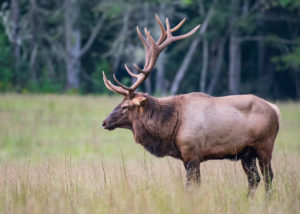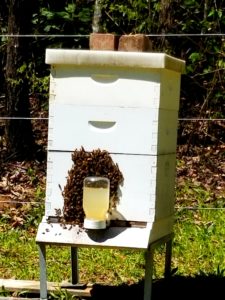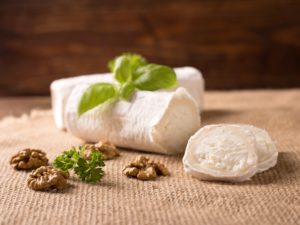July 27, 2020
Elk in the Great Smoky Mountains
Have you seen elk in the Great Smoky Mountains National Park? Our area is home to nearly 200 of the magnificent animals.
Elks are awe-inspiring creatures. The males can weigh up to 700 pounds. The females fiercely defend their offspring and may charge challengers. For a few weeks during the fall mating season, the males, with fully developed racks, bugle and fight to get the attention of the females. The females gather in groups, called harems, on the edge of the fighting fields.
Large herds of elk once roamed along the Appalachian Mountain Range from George to Canada. But, due to overhunting and habitat destruction, the species disappeared from the region in the 1800’s. The National Park Service determined it was appropriate to bring back a native species that had been eliminated from park lands. A small herd of 25 of the animals was reintroduced to the park in 2001. As part of the experiment, the animals were outfitted with radio collars. In 2002 another 27 animals were brought to the area. This reintroduction has been very successful and today the population flourishes.
Best Places to View Elk
The elks have become celebrities, attracting many visitors each year. Most of the elk can be found in the Cataloochee area in the southeastern area of the park. They may be active on cloudy summer days and before or after storms. But the best time to spot them is early morning or late evening. The Park Service reminds you to enjoy the animals from a distance and use binoculars for close-up views. In fact, approaching within 150 feet, or any distance that disturbs the animals, is illegal in the park. To avoid fines and arrest, do not enter the field. Remain by the roadside, please. http://www.nps.gov
Please send your pictures to [email protected]. We would love to share them with other guests!
July 20, 2020
Bees Beard to Beat the Heat
One of our guests pointed to our honeybees clustered on the outside of the hive and said it looked like a “beard”. They wondered why the bees would do this. We have an answer!
“Bearding” is the term which refers to bees accumulating at the front of the hive. They appear calm and fan their wings in unison. They are likely to do this on hot and humid days. By clustering outside they provide more space inside the hive to keep the temperature and humidity within acceptable ranges. Raising brood requires temperatures between 90 and 97 degrees F. They remove their own body heat from the hive to lower the temperature. They also use their wings to push cooler air into the entrance, lowering the temperature even more. The proper humidity is necessary for nectar to evaporate and become honey.
Bee keepers sometimes confuse bearding bees with those getting ready to swarm. But if it is a hot and humid day, chances are good that they are merely bearding. Bearding bees also face the same direction as they fan. This helps cool down the temperature of the hive.
Healthy Bees Beard
According to Kelley Bees http://www.kelleybees.com/blog Bearding is a sign of a strong bee colony that is in good health. It is an indication that the hive contains a good number of bees and that they are preparing for winter by keeping the honey at the correct temperature.
Bees may beard for weeks during the hottest part of the summer. The workers are very skilled at temperature control. Worker bees may also spread water on the rims of cells to set up cooling by evaporation. They can create air currents by fanning their wings. And they adjust the temperature by expanding and contracting the size of the cluster.
We help the bees by providing a source of fresh, clean water. A hive of bees can use as much as a liter of water in a day! We also have painted the hives white so that the sunlight will be reflected, not absorbed.
We are fascinated by our honey bees and are glad that our guests are interested as well!
July 13, 2020
Celebrate Summer with Pesto
This is the time of summer when the basil in our garden here at Buckhorn is ready to pick. Combining it with dairy creates the perfect appetizer for a summer evening out on the patio. This recipe is from the 1988 edition of Easy Entertaining with Marlene Sorosky. I have made it many times and served it with a variety of crackers. A good wine pairing might be an Australian sauvignon blanc. The green, herbaceous notes of the wine complements the pesto flavors and the bright acidity will act as a palate cleanser. This recipe serves 16.
PESTO
2 large garlic cloves, peeled
2 cups (about 2 ounces) basil leaves (note: if you blanch them a few seconds in boiling water and then plunge in ice water the basil leaves will retain their emerald green hue)
2/3 cup grated parmesan cheese
2/3 cup chopped walnuts
¼ cup olive oil
CHEESECAKE
11 ounces cream cheese at room temperature
¾ cup ricotta cheese (about 6 ounces)
8 ounces goat cheese
3 eggs, at room temperature
½ cup sour cream
To make the pesto, mince garlic in a food processor. Add basil, cheese, and walnuts and process until ground. Add oil and process to a thick paste.
To make cheesecake, butter an 8 ½” springform pan. Preheat oven to 350 F. Mix together cream cheese, ricotta, and goat cheese until well blended. Mix in eggs until thoroughly incorporated. Add sour cream and process until well blended. Pour into springform. Bake for 45 to 55 minutes. The top will be golden and the center will still jiggle. Remove to rack and cool completely. When ready to serve, remove sides of pan and spread pesto evenly over the top. Sun dried tomato strips make a lovely garnish. Sit back and wait for the compliments!







Gatlinburg Weather
Click for weather forecast